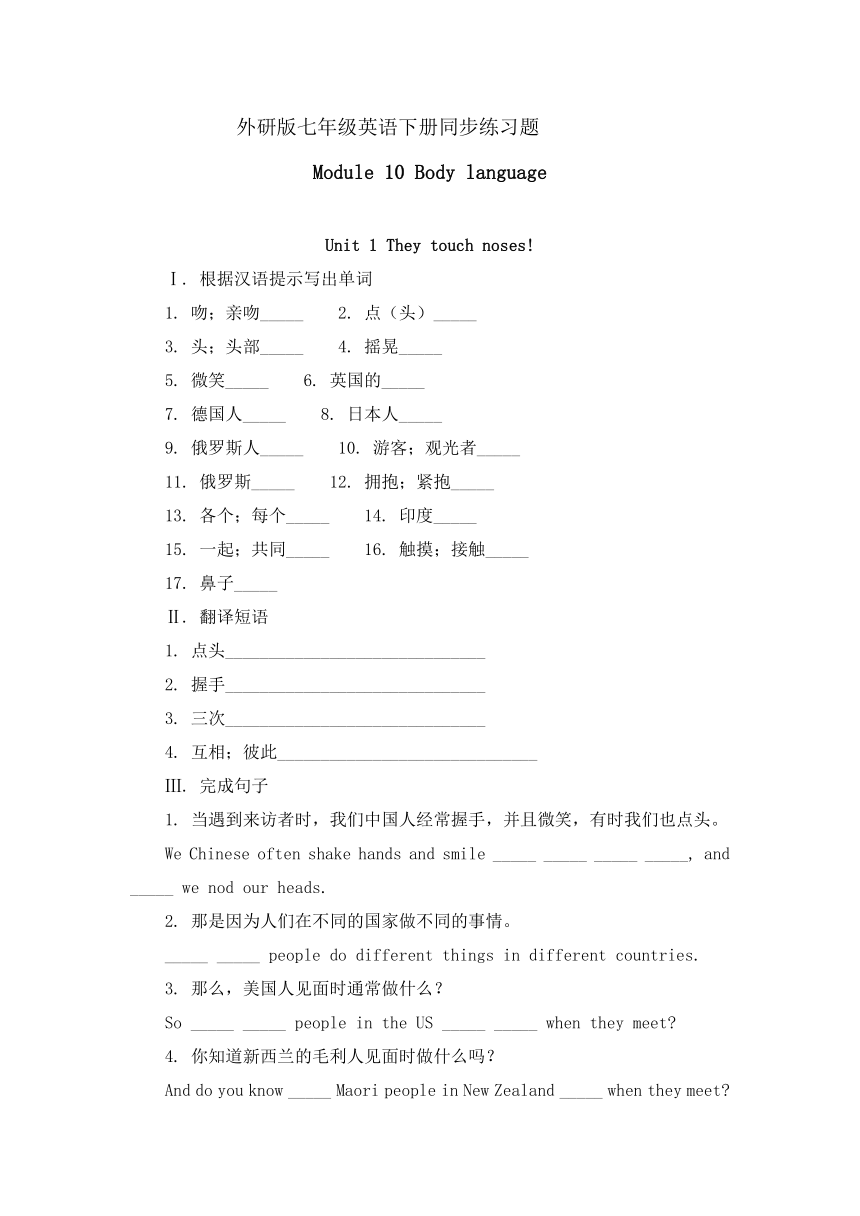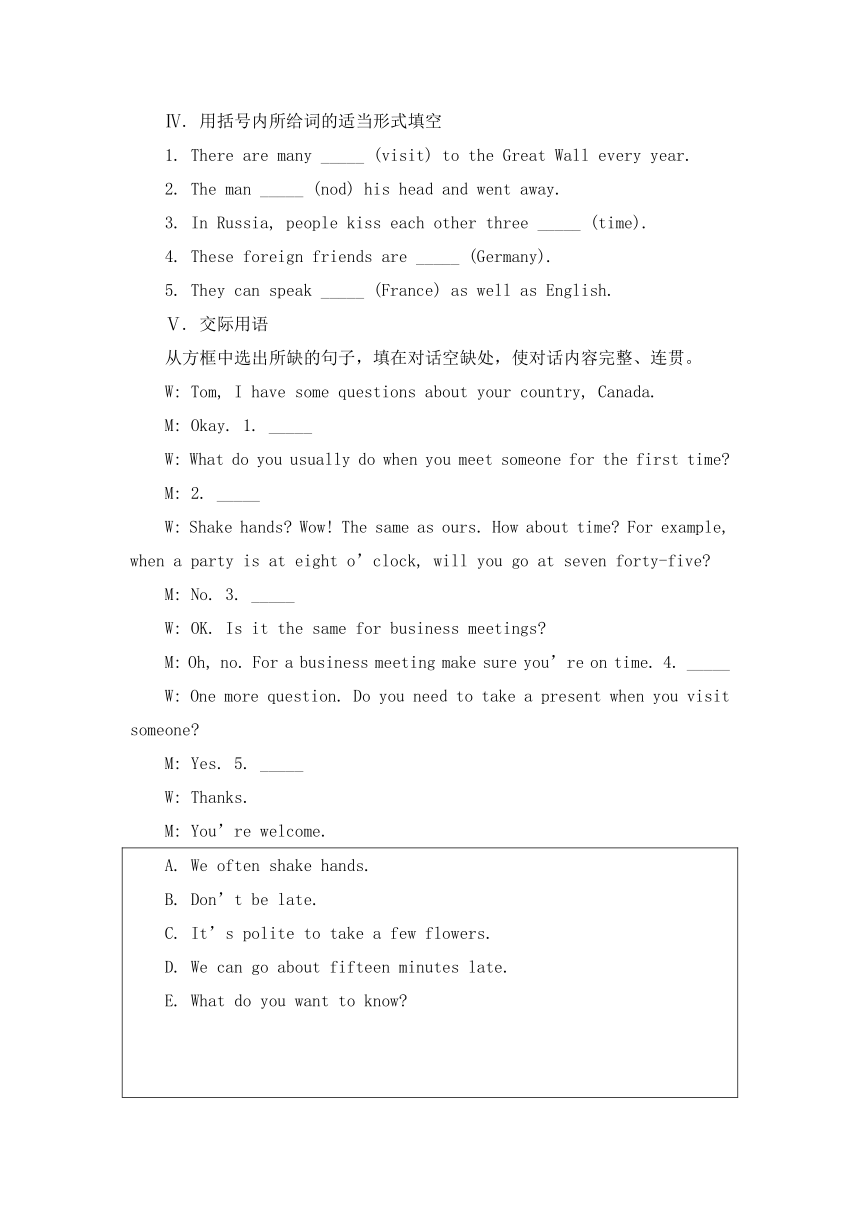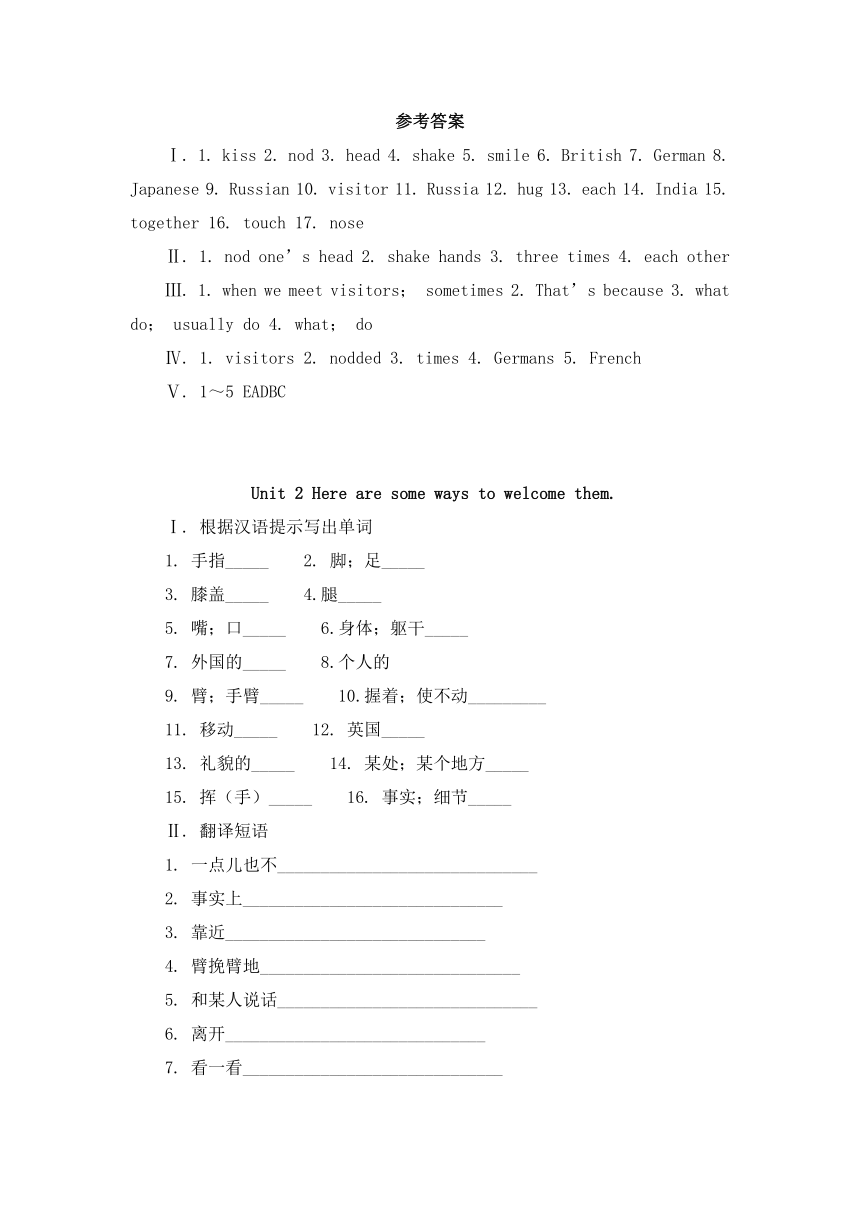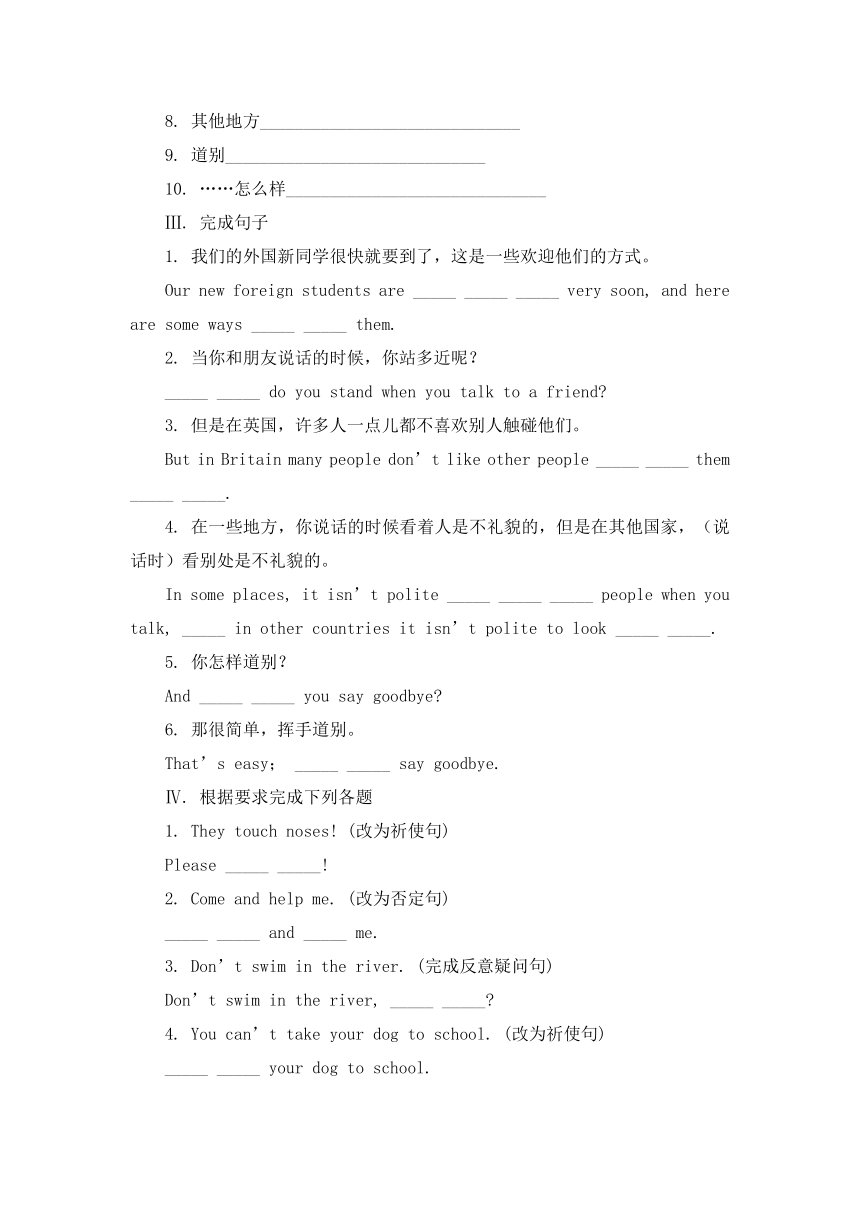外研版七年级下册Module10 holiday journey 同步练习题(含答案)
文档属性
| 名称 | 外研版七年级下册Module10 holiday journey 同步练习题(含答案) |

|
|
| 格式 | docx | ||
| 文件大小 | 24.4KB | ||
| 资源类型 | 教案 | ||
| 版本资源 | 外研版 | ||
| 科目 | 英语 | ||
| 更新时间 | 2023-02-21 13:41:13 | ||
图片预览





文档简介
外研版七年级英语下册同步练习题
Module 10 Body language
Unit 1 They touch noses!
Ⅰ. 根据汉语提示写出单词
1. 吻;亲吻_____ 2. 点(头)_____
3. 头;头部_____ 4. 摇晃_____
5. 微笑_____ 6. 英国的_____
7. 德国人_____ 8. 日本人_____
9. 俄罗斯人_____ 10. 游客;观光者_____
11. 俄罗斯_____ 12. 拥抱;紧抱_____
13. 各个;每个_____ 14. 印度_____
15. 一起;共同_____ 16. 触摸;接触_____
17. 鼻子_____
Ⅱ. 翻译短语
1. 点头______________________________
2. 握手______________________________
3. 三次______________________________
4. 互相;彼此______________________________
Ⅲ. 完成句子
1. 当遇到来访者时,我们中国人经常握手,并且微笑,有时我们也点头。
We Chinese often shake hands and smile _____ _____ _____ _____, and _____ we nod our heads.
2. 那是因为人们在不同的国家做不同的事情。
_____ _____ people do different things in different countries.
3. 那么,美国人见面时通常做什么?
So _____ _____ people in the US _____ _____ when they meet
4. 你知道新西兰的毛利人见面时做什么吗?
And do you know _____ Maori people in New Zealand _____ when they meet
Ⅳ. 用括号内所给词的适当形式填空
1. There are many _____ (visit) to the Great Wall every year.
2. The man _____ (nod) his head and went away.
3. In Russia, people kiss each other three _____ (time).
4. These foreign friends are _____ (Germany).
5. They can speak _____ (France) as well as English.
Ⅴ. 交际用语
从方框中选出所缺的句子,填在对话空缺处,使对话内容完整、连贯。
W: Tom, I have some questions about your country, Canada.
M: Okay. 1. _____
W: What do you usually do when you meet someone for the first time
M: 2. _____
W: Shake hands Wow! The same as ours. How about time For example, when a party is at eight o’clock, will you go at seven forty-five
M: No. 3. _____
W: OK. Is it the same for business meetings
M: Oh, no. For a business meeting make sure you’re on time. 4. _____
W: One more question. Do you need to take a present when you visit someone
M: Yes. 5. _____
W: Thanks.
M: You’re welcome.
A. We often shake hands. B. Don’t be late. C. It’s polite to take a few flowers. D. We can go about fifteen minutes late. E. What do you want to know
1. _____ 2. _____ 3. _____ 4. _____ 5. _____
参考答案
Ⅰ. 1. kiss 2. nod 3. head 4. shake 5. smile 6. British 7. German 8. Japanese 9. Russian 10. visitor 11. Russia 12. hug 13. each 14. India 15. together 16. touch 17. nose
Ⅱ. 1. nod one’s head 2. shake hands 3. three times 4. each other
Ⅲ. 1. when we meet visitors; sometimes 2. That’s because 3. what do; usually do 4. what; do
Ⅳ. 1. visitors 2. nodded 3. times 4. Germans 5. French
Ⅴ. 1~5 EADBC
Unit 2 Here are some ways to welcome them.
Ⅰ. 根据汉语提示写出单词
1. 手指_____ 2. 脚;足_____
3. 膝盖_____ 4.腿_____
5. 嘴;口_____ 6.身体;躯干_____
7. 外国的_____ 8.个人的
9. 臂;手臂_____ 10.握着;使不动_________
11. 移动_____ 12. 英国_____
13. 礼貌的_____ 14. 某处;某个地方_____
15. 挥(手)_____ 16. 事实;细节_____
Ⅱ. 翻译短语
1. 一点儿也不______________________________
2. 事实上______________________________
3. 靠近______________________________
4. 臂挽臂地______________________________
5. 和某人说话______________________________
6. 离开______________________________
7. 看一看______________________________
8. 其他地方______________________________
9. 道别______________________________
10. ……怎么样______________________________
Ⅲ. 完成句子
1. 我们的外国新同学很快就要到了,这是一些欢迎他们的方式。
Our new foreign students are _____ _____ _____ very soon, and here are some ways _____ _____ them.
2. 当你和朋友说话的时候,你站多近呢?
_____ _____ do you stand when you talk to a friend
3. 但是在英国,许多人一点儿都不喜欢别人触碰他们。
But in Britain many people don’t like other people _____ _____ them _____ _____.
4. 在一些地方,你说话的时候看着人是不礼貌的,但是在其他国家,(说话时)看别处是不礼貌的。
In some places, it isn’t polite _____ _____ _____ people when you talk, _____ in other countries it isn’t polite to look _____ _____.
5. 你怎样道别?
And _____ _____ you say goodbye
6. 那很简单,挥手道别。
That’s easy; _____ _____ say goodbye.
Ⅳ. 根据要求完成下列各题
1. They touch noses! (改为祈使句)
Please _____ _____!
2. Come and help me. (改为否定句)
_____ _____ and _____ me.
3. Don’t swim in the river. (完成反意疑问句)
Don’t swim in the river, _____ _____
4. You can’t take your dog to school. (改为祈使句)
_____ _____ your dog to school.
5. What about going swimming this Sunday (改为同义句)
_____ _____ going swimming this Sunday
6. To look at people when you talk is not polite. (改为同义句)
_____ _____ _____ to look at people when you talk.
Ⅴ. 单项选择
1. Here are some ways _____ English.
A. learn B. learns
C. learning D. to learn
2. Since you have finished your homework, how about _____
A. go to run B. go running
C. going to run D. going running
3. They went home together arm _____ arm.
A. on B. by
C. in D. to
4. It’s dangerous _____ with the wild animals.
A. for us to play B. of us playing
C. for us playing D. of us to play
5. —Where would you like to go on vacation, Lily
—It’s hot here. I’d like to go _____.
A. anywhere
B. cool somewhere
C. somewhere cool
参考答案
Ⅰ. 1. finger 2. foot 3. knee 4. leg 5. mouth 6. body 7. foreign 8. personal 9. arm 10. hold 11. move 12. Britain 13. polite 14. somewhere 15. wave 16. fact
Ⅱ. 1. not... at all 2. in fact 3. close to 4. arm in arm 5. talk to sb 6. move away 7. look at 8. somewhere else 9. say goodbye 10. what/how about...
Ⅲ. 1. going to arrive; to welcome
2. How close 3. to touch; at all
4. to look at; but; somewhere else
5. how do 6. wave to
Ⅳ. 1. touch noses 2. Don’t come; help 3. will you 4. Don’t take 5. How about 6. It isn’t polite
Ⅴ. DDCAC
Unit 3 Language in use
Ⅰ. 翻译短语
1.站队______________________________
2.问好______________________________
3.准时______________________________
4.开门______________________________
5.在日本______________________________
6.小心______________________________
Ⅱ. 完成句子
1. 给他们更多的私人空间。
_____ _____ _____ personal space.
2. 挥手告别。
Wave _____ _____ goodbye.
3. 当你过马路时要小心!
_____ careful when you cross the road!
4. 不要站得离北美人太近。
Don’t _____ _____ _____ _____ North Americans.
5. 在日本,人们鞠躬说“谢谢”。
In Japan, people _____ _____ _____ "thank you".
6. 小孩儿和年轻人向年龄较大的人问候时,会鞠躬鞠得更低。
Children and young people _____ _____ _____ they greet older people.
Ⅲ. 用括号内所给词的适当形式填空
1. _____ (not walk) in the forest. It’s dangerous.
2. It’s important _____ (learn) English well.
3. It’s not polite to ask a _____ (woman) age.
4. _____ (listen) to the teacher carefully.
5. It’s _____ (polite) to point at others with your chopsticks.
Ⅳ. 短文填空
从方框中选出单词,并用其适当形式填空,使短文内容完整、连贯。
ask, say, enter, bad, first, example, family, dirty, before, enough
Different countries and different people have different manners. We must find out their customs so that they will not think us impolite. Here are 1. _____ of the things that a person with a good education does or does not do.
If you visit a Chinese 2. _____, you should knock at the door 3. _____ When the door opens, you will not move 4. _____ the host says "Come in, please." After you 5. _____ the room, you would not sit down until the host 6. _____ you to take a seat. When a cup of tea is put on a tea table, you will 7. _____ "Thank you" and receive it with two hands, not one hand, or they will think you have 8. _____ manners. Before entering a house in Japan, it is a good manner to take off your shoes. In European countries, even though shoes sometimes become very 9. _____, this is not done. In a Malay (马来人的) house, a visitor never finishes the food on the table. He leaves a little to show that he has had 10. _____. In England, a visitor always finishes a drink or the food to show that he has enjoyed it. This will make the host pleased.
1. _____ 2. _____ 3. _____ 4. _____
5. _____ 6. _____ 7. _____ 8. _____
9. _____ 10. _____
Ⅴ. 任务型阅读
The meanings of colours are sometimes very different in different cultures. For example, in some cultures, blue is a common clothing colour for little boys, and pink is a common clothing colour for little girls. In other cultures, other colours are common for boys and girls.
There are also different colours for special days in different cultures. For example, white is the traditional colour of a wedding dress in some cultures, but other colours are traditional in other cultures. In China, a bride often wears red clothes because red can bring good luck and it’s the symbol of happiness.
For some people, white is a happy colour. For others, it’s a sad colour. For some people, red is a beautiful and lucky colour. For others, it’s a very sad colour.
What are the meanings of different colours in YOUR culture
任务一:根据短文内容完成句子。
1. In some cultures, _____ is a common clothing colour for little boys.
2. White is the traditional colour of a _____ _____ in some cultures.
任务二:根据短文内容回答问题。
3. What is a common clothing colour for little girls in some cultures
____________________________________________________________
4. What is the traditional colour of a wedding dress in our culture
____________________________________________________________
任务三:找出本文的主题句。
5. ____________________________________________________________
参考答案
Ⅰ. 1. stand in line 2. say hello 3. on time 4. open doors 5. in Japan 6. be careful
Ⅱ. 1. Give them more 2. to say 3. Be 4. stand too close to 5. bow to say 6. bow lower when
Ⅲ. 1. Don’t walk 2. to learn 3. woman’s 4. Listen 5. impolite
Ⅳ. 1. examples 2. family 3. first 4. before 5. enter 6. asks 7. say 8. bad 9. dirty 10. enough
Ⅴ. 1. blue 2. wedding dress 3. Pink. 4. Red. 5
. The meanings of colours are sometimes very different in different cultures.
Module 10 Body language
Unit 1 They touch noses!
Ⅰ. 根据汉语提示写出单词
1. 吻;亲吻_____ 2. 点(头)_____
3. 头;头部_____ 4. 摇晃_____
5. 微笑_____ 6. 英国的_____
7. 德国人_____ 8. 日本人_____
9. 俄罗斯人_____ 10. 游客;观光者_____
11. 俄罗斯_____ 12. 拥抱;紧抱_____
13. 各个;每个_____ 14. 印度_____
15. 一起;共同_____ 16. 触摸;接触_____
17. 鼻子_____
Ⅱ. 翻译短语
1. 点头______________________________
2. 握手______________________________
3. 三次______________________________
4. 互相;彼此______________________________
Ⅲ. 完成句子
1. 当遇到来访者时,我们中国人经常握手,并且微笑,有时我们也点头。
We Chinese often shake hands and smile _____ _____ _____ _____, and _____ we nod our heads.
2. 那是因为人们在不同的国家做不同的事情。
_____ _____ people do different things in different countries.
3. 那么,美国人见面时通常做什么?
So _____ _____ people in the US _____ _____ when they meet
4. 你知道新西兰的毛利人见面时做什么吗?
And do you know _____ Maori people in New Zealand _____ when they meet
Ⅳ. 用括号内所给词的适当形式填空
1. There are many _____ (visit) to the Great Wall every year.
2. The man _____ (nod) his head and went away.
3. In Russia, people kiss each other three _____ (time).
4. These foreign friends are _____ (Germany).
5. They can speak _____ (France) as well as English.
Ⅴ. 交际用语
从方框中选出所缺的句子,填在对话空缺处,使对话内容完整、连贯。
W: Tom, I have some questions about your country, Canada.
M: Okay. 1. _____
W: What do you usually do when you meet someone for the first time
M: 2. _____
W: Shake hands Wow! The same as ours. How about time For example, when a party is at eight o’clock, will you go at seven forty-five
M: No. 3. _____
W: OK. Is it the same for business meetings
M: Oh, no. For a business meeting make sure you’re on time. 4. _____
W: One more question. Do you need to take a present when you visit someone
M: Yes. 5. _____
W: Thanks.
M: You’re welcome.
A. We often shake hands. B. Don’t be late. C. It’s polite to take a few flowers. D. We can go about fifteen minutes late. E. What do you want to know
1. _____ 2. _____ 3. _____ 4. _____ 5. _____
参考答案
Ⅰ. 1. kiss 2. nod 3. head 4. shake 5. smile 6. British 7. German 8. Japanese 9. Russian 10. visitor 11. Russia 12. hug 13. each 14. India 15. together 16. touch 17. nose
Ⅱ. 1. nod one’s head 2. shake hands 3. three times 4. each other
Ⅲ. 1. when we meet visitors; sometimes 2. That’s because 3. what do; usually do 4. what; do
Ⅳ. 1. visitors 2. nodded 3. times 4. Germans 5. French
Ⅴ. 1~5 EADBC
Unit 2 Here are some ways to welcome them.
Ⅰ. 根据汉语提示写出单词
1. 手指_____ 2. 脚;足_____
3. 膝盖_____ 4.腿_____
5. 嘴;口_____ 6.身体;躯干_____
7. 外国的_____ 8.个人的
9. 臂;手臂_____ 10.握着;使不动_________
11. 移动_____ 12. 英国_____
13. 礼貌的_____ 14. 某处;某个地方_____
15. 挥(手)_____ 16. 事实;细节_____
Ⅱ. 翻译短语
1. 一点儿也不______________________________
2. 事实上______________________________
3. 靠近______________________________
4. 臂挽臂地______________________________
5. 和某人说话______________________________
6. 离开______________________________
7. 看一看______________________________
8. 其他地方______________________________
9. 道别______________________________
10. ……怎么样______________________________
Ⅲ. 完成句子
1. 我们的外国新同学很快就要到了,这是一些欢迎他们的方式。
Our new foreign students are _____ _____ _____ very soon, and here are some ways _____ _____ them.
2. 当你和朋友说话的时候,你站多近呢?
_____ _____ do you stand when you talk to a friend
3. 但是在英国,许多人一点儿都不喜欢别人触碰他们。
But in Britain many people don’t like other people _____ _____ them _____ _____.
4. 在一些地方,你说话的时候看着人是不礼貌的,但是在其他国家,(说话时)看别处是不礼貌的。
In some places, it isn’t polite _____ _____ _____ people when you talk, _____ in other countries it isn’t polite to look _____ _____.
5. 你怎样道别?
And _____ _____ you say goodbye
6. 那很简单,挥手道别。
That’s easy; _____ _____ say goodbye.
Ⅳ. 根据要求完成下列各题
1. They touch noses! (改为祈使句)
Please _____ _____!
2. Come and help me. (改为否定句)
_____ _____ and _____ me.
3. Don’t swim in the river. (完成反意疑问句)
Don’t swim in the river, _____ _____
4. You can’t take your dog to school. (改为祈使句)
_____ _____ your dog to school.
5. What about going swimming this Sunday (改为同义句)
_____ _____ going swimming this Sunday
6. To look at people when you talk is not polite. (改为同义句)
_____ _____ _____ to look at people when you talk.
Ⅴ. 单项选择
1. Here are some ways _____ English.
A. learn B. learns
C. learning D. to learn
2. Since you have finished your homework, how about _____
A. go to run B. go running
C. going to run D. going running
3. They went home together arm _____ arm.
A. on B. by
C. in D. to
4. It’s dangerous _____ with the wild animals.
A. for us to play B. of us playing
C. for us playing D. of us to play
5. —Where would you like to go on vacation, Lily
—It’s hot here. I’d like to go _____.
A. anywhere
B. cool somewhere
C. somewhere cool
参考答案
Ⅰ. 1. finger 2. foot 3. knee 4. leg 5. mouth 6. body 7. foreign 8. personal 9. arm 10. hold 11. move 12. Britain 13. polite 14. somewhere 15. wave 16. fact
Ⅱ. 1. not... at all 2. in fact 3. close to 4. arm in arm 5. talk to sb 6. move away 7. look at 8. somewhere else 9. say goodbye 10. what/how about...
Ⅲ. 1. going to arrive; to welcome
2. How close 3. to touch; at all
4. to look at; but; somewhere else
5. how do 6. wave to
Ⅳ. 1. touch noses 2. Don’t come; help 3. will you 4. Don’t take 5. How about 6. It isn’t polite
Ⅴ. DDCAC
Unit 3 Language in use
Ⅰ. 翻译短语
1.站队______________________________
2.问好______________________________
3.准时______________________________
4.开门______________________________
5.在日本______________________________
6.小心______________________________
Ⅱ. 完成句子
1. 给他们更多的私人空间。
_____ _____ _____ personal space.
2. 挥手告别。
Wave _____ _____ goodbye.
3. 当你过马路时要小心!
_____ careful when you cross the road!
4. 不要站得离北美人太近。
Don’t _____ _____ _____ _____ North Americans.
5. 在日本,人们鞠躬说“谢谢”。
In Japan, people _____ _____ _____ "thank you".
6. 小孩儿和年轻人向年龄较大的人问候时,会鞠躬鞠得更低。
Children and young people _____ _____ _____ they greet older people.
Ⅲ. 用括号内所给词的适当形式填空
1. _____ (not walk) in the forest. It’s dangerous.
2. It’s important _____ (learn) English well.
3. It’s not polite to ask a _____ (woman) age.
4. _____ (listen) to the teacher carefully.
5. It’s _____ (polite) to point at others with your chopsticks.
Ⅳ. 短文填空
从方框中选出单词,并用其适当形式填空,使短文内容完整、连贯。
ask, say, enter, bad, first, example, family, dirty, before, enough
Different countries and different people have different manners. We must find out their customs so that they will not think us impolite. Here are 1. _____ of the things that a person with a good education does or does not do.
If you visit a Chinese 2. _____, you should knock at the door 3. _____ When the door opens, you will not move 4. _____ the host says "Come in, please." After you 5. _____ the room, you would not sit down until the host 6. _____ you to take a seat. When a cup of tea is put on a tea table, you will 7. _____ "Thank you" and receive it with two hands, not one hand, or they will think you have 8. _____ manners. Before entering a house in Japan, it is a good manner to take off your shoes. In European countries, even though shoes sometimes become very 9. _____, this is not done. In a Malay (马来人的) house, a visitor never finishes the food on the table. He leaves a little to show that he has had 10. _____. In England, a visitor always finishes a drink or the food to show that he has enjoyed it. This will make the host pleased.
1. _____ 2. _____ 3. _____ 4. _____
5. _____ 6. _____ 7. _____ 8. _____
9. _____ 10. _____
Ⅴ. 任务型阅读
The meanings of colours are sometimes very different in different cultures. For example, in some cultures, blue is a common clothing colour for little boys, and pink is a common clothing colour for little girls. In other cultures, other colours are common for boys and girls.
There are also different colours for special days in different cultures. For example, white is the traditional colour of a wedding dress in some cultures, but other colours are traditional in other cultures. In China, a bride often wears red clothes because red can bring good luck and it’s the symbol of happiness.
For some people, white is a happy colour. For others, it’s a sad colour. For some people, red is a beautiful and lucky colour. For others, it’s a very sad colour.
What are the meanings of different colours in YOUR culture
任务一:根据短文内容完成句子。
1. In some cultures, _____ is a common clothing colour for little boys.
2. White is the traditional colour of a _____ _____ in some cultures.
任务二:根据短文内容回答问题。
3. What is a common clothing colour for little girls in some cultures
____________________________________________________________
4. What is the traditional colour of a wedding dress in our culture
____________________________________________________________
任务三:找出本文的主题句。
5. ____________________________________________________________
参考答案
Ⅰ. 1. stand in line 2. say hello 3. on time 4. open doors 5. in Japan 6. be careful
Ⅱ. 1. Give them more 2. to say 3. Be 4. stand too close to 5. bow to say 6. bow lower when
Ⅲ. 1. Don’t walk 2. to learn 3. woman’s 4. Listen 5. impolite
Ⅳ. 1. examples 2. family 3. first 4. before 5. enter 6. asks 7. say 8. bad 9. dirty 10. enough
Ⅴ. 1. blue 2. wedding dress 3. Pink. 4. Red. 5
. The meanings of colours are sometimes very different in different cultures.
同课章节目录
- Module 1 Lost and found
- Unit 1 Whose bag is this?
- Unit 2 Are they yours?
- Unit 3 Language in use
- Module 2 What can you do ?
- Unit 1 I can play the piano
- Unit 2 I can run really fast
- Unit 3 Language in use
- Module 3 Making plans
- Unit 1 What are you going to do at the weekends?
- Unit 2 We're going to cheer the players.
- Unit 3 Language in use
- Module 4 Life in the future
- Unit 1 Everyone will study at home
- Unit 2 Every family will have a small plane.
- Unit 3 Language in use
- Module 5 Shopping
- Unit 1 What can I do for you?
- Unit 2 You can buy everything on the Internet
- Unit 3 Language in use
- Module 6 Around town
- Unit 1 Could you tell me how to get to the Nationa
- Unit 2 The London Eye is on your right.
- Unit 3 Language in use
- Revision module A
- Module 7 My past life
- Unit 1 I was born in a small village.
- Unit 2 I was born in Quincy.
- Unit 3 Language in use
- Module 8 Story time
- Unit 1 Once upon a time….
- Unit 2 Goldilocks hurried out of the house.
- Unit 3 Language in use
- Module 9 Life history
- Unit 1 He left school and began work at the age of
- Unit 2 He decided to be an actor.
- Unit 3 Language in use
- Module 10 A holiday journey
- Unit 1 What did you do?
- Unit 2 This morning we took a walk.
- Unit 3 Language in use
- Module 11 Body language
- Unit 1 They touch noses!
- Unit 2 Here are some ways to welcome them.
- Unit 3 Language in use
- Module 12 Western music
- Unit 1 It's so beautiful!
- Unit 2 Vienna is the centre of European classical
- Unit 3 Language in use
- Revision module B
